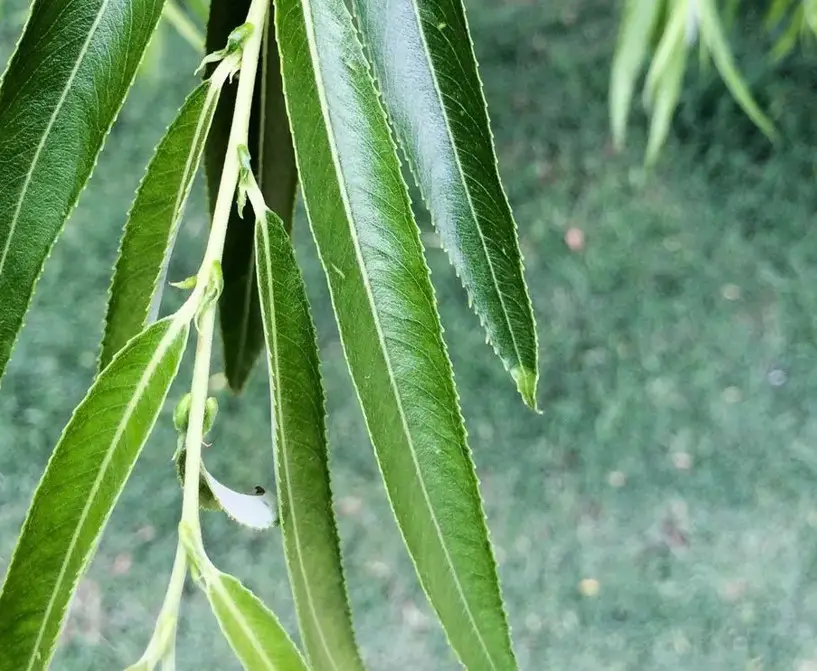In this detailed care guide, we’ll unravel the mysteries surrounding the Globe Willow Tree (Salix matsudana Navajo), a remarkable species renowned for its round, upright growth and single trunk.
Originating from China, this resilient tree has found its place in various climates, thriving in both the Great Lakes region and the arid landscapes of the southwestern United States.
About Globe Willow Tree

Hankow willows, or globe willows (Salix matsudana ‘Navajo’), are quick-growing trees distinguished by their globe-shaped canopies. These trees are native to eastern Asia and are highly valued for their quick growth and flexibility, which makes them great options for shade in parks, lawns, and places close to lakes and streams. In early spring, globe willows are among the first trees to leaf out, bringing brilliant greenery to the scene.
With heights ranging from 20 to 70 feet and widths ranging from 35 to 70 feet, these trees make a significant impression in any environment. In spring, their thin, bright green leaves appear; by summer, they have grown to a dark green, and in the fall, they turn a stunning yellow. The globe willow’s unassuming flowers and fruit do not take away from the tree’s attractive appearance, even with their decorative foliage.
Globe willows may grow in either full sun or partial shade and are suited for Zones 4 through 9. They are heavy water users, usually requiring a weekly watering every 1-2 ½ weeks. Since these trees can be severely affected by cold in severe weather, it’s critical to trim any dead, diseased, or damaged branches and limbs in the summer or fall to preserve the health and beauty of the tree.
Globe Willow Tree Care And Growing Guide

Globe Willow Trees are popular for their graceful, weeping branches and attractive foliage. Proper care is essential to maintaining their health and appearance. Here’s a comprehensive guide to caring for and growing Globe Willow trees:
Planting
When planting a Globe Willow, choosing the right location is crucial. Select a spot with full sun to partial shade and ensure there is enough space for the tree to grow, as Globe Willows can reach a height of 30 to 50 feet and a spread of 30 to 40 feet.
Regarding soil, Globe Willows prefer moist, well-drained soil but can tolerate a variety of soil types, including clay and sandy soils. The soil pH should range from 6.0 to 8.0, which is slightly acidic to slightly alkaline.
The planting process involves digging a hole twice as wide and as deep as the root ball. Place the tree in the hole so that the root ball is level with, or slightly above, the ground surface. Then, backfill with soil, pressing down to eliminate air pockets. Finally, water thoroughly to settle the soil around the roots.
Watering
Watering Globe Willows regularly is essential, particularly during the first few years, to establish a robust root system. During this initial period, it is important to keep the soil consistently moist but not waterlogged to promote healthy growth.
Mature Globe Willows become more drought-tolerant as they age; however, they will still benefit from regular watering during dry spells to maintain their health and vitality. Ensuring that mature trees receive adequate moisture during periods of drought will help them thrive and continue to grow strong, lush foliage.
Regular watering, adjusted to the needs of the tree depending on its age and weather conditions, is key to the long-term success of Globe Willows in your landscape.
Mulching
Applying mulch around the base of a Globe Willow is highly beneficial for its overall health and growth. Begin by spreading a 2-4 inch layer of mulch around the tree, extending out to the drip line, which is the area directly beneath the outer circumference of the tree’s branches. This mulch serves multiple purposes: it helps retain soil moisture by reducing evaporation, regulates soil temperature by insulating the roots from extreme temperatures, and reduces weed competition by suppressing the growth of unwanted plants that might compete for nutrients and water.
However, it’s crucial to ensure that the mulch is kept a few inches away from the trunk of the tree. Piling mulch directly against the trunk can trap moisture against the bark, leading to rot and making the tree susceptible to disease and pests. By maintaining a gap between the mulch and the trunk, you promote better air circulation and prevent these potential problems.
Overall, proper mulching not only supports the tree’s immediate needs by maintaining a stable and moist environment but also contributes to its long-term health and stability. It’s an easy yet effective practice that can significantly enhance the well-being of your Globe Willow.
Fertilizing
Fertilizing your Globe Willow is an important step to ensure vigorous growth and overall health. Apply fertilizer in early spring before new growth begins, using a balanced formula such as a 10-10-10 (N-P-K) mixture.
This balanced fertilizer provides equal parts nitrogen, phosphorus, and potassium, essential nutrients that support robust foliage, root development, and overall plant health. Be sure to follow the manufacturer’s instructions carefully regarding the application rate and method to avoid over-fertilizing, which can harm the tree.
Proper fertilization in early spring sets the stage for a thriving growing season, ensuring your Globe Willow remains lush and vibrant.
Pruning
Pruning is an essential practice for maintaining the health, appearance, and structure of your Globe Willow tree. It’s best to prune in late winter or early spring before new growth begins, as this allows the tree to heal quickly and efficiently. When pruning, start by removing any dead, damaged, or diseased branches. These branches not only detract from the tree’s aesthetic appeal but can also pose risks such as disease spread or potential hazards if they were to fall.
Additionally, thinning out crowded branches is crucial to improving air circulation and light penetration throughout the canopy. This helps reduce the risk of fungal diseases and promotes better overall growth and vitality. By selectively removing branches that are crossing or rubbing against each other, you can create a more open and balanced canopy.
Finally, maintain a balanced shape by selectively cutting back branches as needed. This involves carefully assessing the tree’s overall form and selectively pruning to encourage a balanced growth pattern. Avoid excessive pruning, as this can weaken the tree and make it more susceptible to stress and disease.
Pest and Disease Management
Managing pests and diseases is crucial for maintaining the health and vitality of your Globe Willow tree. Globe Willows are susceptible to various pests, including aphids, caterpillars, and borers. Regular inspection of the tree is essential to detecting any signs of infestation promptly. If pests are detected, it’s important to treat them promptly using appropriate insecticides or organic methods to prevent damage to the tree.
In addition to pests, Globe Willows can also be affected by diseases such as cankers, leaf spot, and powdery mildew. To minimize the risk of disease, ensure good air circulation around the tree by properly spacing it from other plants and structures. Avoid overhead watering, as this can create a moist environment that is conducive to disease development.
If diseases do occur, take immediate action by removing and destroying affected plant parts to prevent the spread of infection. In some cases, fungicides may be necessary to effectively manage the disease. However, always follow label instructions carefully and consider using organic or environmentally friendly options whenever possible.
General Tips
Here are some general tips for caring for Globe Willows:
- Regular Pruning: Due to their rapid growth rate, Globe Willows can develop weak wood that is prone to breakage. Regular pruning is essential for maintaining a strong and stable structure. By selectively removing branches and thinning out crowded areas, you can help prevent potential hazards and promote healthier growth.
- Suitable Landscapes: Globe Willows are best suited for larger landscapes where their size and root spread won’t interfere with nearby structures or underground utilities. Planting them in spacious areas allows them to thrive without posing risks to the surrounding infrastructure.
- Monitor for Signs of Stress: Keep an eye out for signs of stress in your Globe Willow, such as yellowing leaves or dieback. These symptoms may indicate underlying issues such as water stress, nutrient deficiencies, or pest and disease problems. Regular monitoring allows you to identify and address issues promptly, helping to maintain the health and vigor of your tree.
Globe Willow Tree Natural Issues
The Globe Willow tree has a distinctive round, upright growth habit and a single trunk, setting it apart from the traditional weeping willows. With its impressive height and spread of up to 40 feet upon reaching maturity, the Globe Willow stands out as one of the first trees to herald the arrival of spring with its vibrant green foliage.
Despite its undeniable beauty and early spring charm, the Globe Willow, like many of its willow counterparts, is not without its share of natural challenges. One of the most significant issues lies in its inherent short lifespan. While it may reach maturity around 30 years of age, it begins to decline thereafter. This natural process is further compounded by the tree’s brittle and soft wood, which grows rapidly but is prone to storm damage and splitting at branch crotches.
Prudent care practices can help prolong the life of Globe Willows, such as careful pruning to reduce weight in the canopy, thereby mitigating the risk of breakage during storms. However, it’s important to note that pruning itself can create openings for diseases and fungi to infiltrate the tree. Therefore, striking a delicate balance between promoting structural integrity and minimizing potential harm from pruning wounds is crucial to managing the health and longevity of these beautiful trees.






